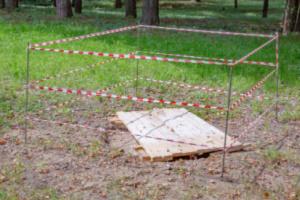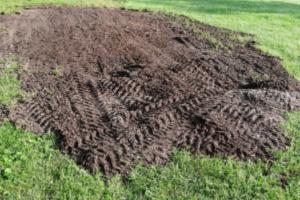Whether your backyard is sprawling or on the smaller side, it is likely a place where your family spends a lot of time, particularly when the weather is favorable. Although your yard may have been in great condition when your home was first built, some areas might become uneven over time, whether it is due to draining issues, settling or other causes. Unfortunately, an uneven lawn isn’t just an eyesore; it can also pose tripping hazards or put those mowing the lawn in danger. Read more and find out what type of dirt to use for leveling yard.
How can you level your yard so it is safer and more visually appealing? There are several types of soil you can use depending on the source and degree of your yard’s unevenness. Here is a look at how to level your yard and which types of dirt to use.
Leveling Deeply Sunken Areas

Troughs, depressions or holes that are deeper than an inch or two should be filled using a good soil mix. When filling in deeper holes, the soil should be compacted gently and then watered moderately to help it settle as the hole is being filled. Simply piling loose soil into the hole and planting grass seed is not recommended because the result will be a sunken area with new grass growing on it.
Always be sure to compact the soil; walking on it is usually enough to compact it sufficiently for these purposes. It is equally important to avoid over-compacting the top of the soil where the grass seed will be sown.
Leveling Minor Depressions
Minor depressions in a yard can be leveled using topdressing with a mix of compost, topsoil and fine sand. Be sure to choose a soil that does not contain any plant debris or mulch as this could smother the grass. Look for a mixture of 40% topsoil, 40% sand and 20% compost. This ratio is ideal as the sand offers good drainage while the compost gives the soil the nutrients it needs to support the growth of grass.
To carry out minor leveling, begin by mixing the leveling mix in a wheelbarrow or a tub with a shovel. It is important to mix it well so the sand and compost fully incorporate into the soil. Then, cover the low areas with the leveling mix, being careful not to add more than half an inch as this could smother the grass. Then, rake the topdressing so it spreads out evenly across the surface.
Next, you should brush the grass back and forth. This will help the leveling mix to make its way down while lifting the blades of grass up. Keep in mind that grass will not thrive if it is covered in soil. Water this area lightly, taking care not to overwater it as this could wash away your leveling mix.
You will want to monitor the area to ensure it is progressing correctly in the following days and weeks. Over time, no dirt should be visible, unless there was a bare spot before topdressing. Should the lawn remain uneven after a few weeks have passed, repeat the process of topdressing, again taking care not to exceed half an inch at a time, until the area is level.
Leveling Small Sunken Areas Covered In Healthy Grass

For smaller sunken areas that have healthy grass growing on top of them, you can use topsoil or potting soil that is free from debris for a technique known as “sweeping the dirt under the carpet”. This entails picking up turf and placing dirt beneath it to level the area.
First, you will want to use a sod cutter or manual lawn edger to cut into the turf along the edges of the area that has sunken. Use clean vertical cuts to reduce root damage and create a patch of turf that can be easily removed and replaced.
Remove the turf patch, taking care to avoid damaging the roots, and place it somewhere that it will not be disturbed by family members or pets. Then, spread a layer of topsoil or potting soil in the hole, using enough to bring it level with the surrounding lawn. Be sure to water the soil lightly as you go to remove air pockets and reduce the potential for future settling. Then, replace the turf patch in its original position, using your foot or hand to push the grass back into place, and water the grass.
Keep an eye on the area and water it as needed so the grass remains healthy. Keep in mind that it may require some extra care at first so it can recover from the trauma of being removed.
Regardless of the method being used, spring is the optimal time of year to level a lawn thanks to its mild conditions. Leveling it in early spring will also allow plenty of time for the lawn to recover before the heat of summer sets in.
Keeping Your Lawn Even
Once you have leveled your lawn, you will want to ensure it remains even. Take care to avoid some of the common causes of uneven lawns, such as mowing the grass at too low of a height. This can cause the grass to be scalped with mower blades, which can damage the roots and open the area up to loss of soil as well as pests.
Other common causes of uneven lawns to look out for include:

- Digging animals
- Thinning grass
- Pests
- Diseases
- Compaction from foot or motorized traffic
- Poor lawn care methods
- Seasonal freezing and thawing
- New fencing or sidewalks on your lawn or your neighbor’s lawn that change the flow of water
Discuss Your Project With Dirt Connections
The dirt grading specialists at Dirt Connections are a valuable resource for projects of all sizes in the Northern Virginia area. We can supply a range of soil types to suit grading and site preparation work at residential and commercial sites. Reach out today to discuss your project or arrange a dirt delivery.
Summary

Dirt Connections was started with one goal in mind: providing quality residential and commercial construction services to clients on time and on budget. Reach out for more information on how we can support your next project.
For your convenience our estimates are free and by appointment. Call 703-940-9949 for a free estimate today!










































